Factor Identification and Prediction for Teen Driver Crash Severity Using Machine Learning: A Case Study
Abstract
1. Introduction
- Step 1: Firstly, perform an Exploratory Data Analysis (EDA) on the collected dataset. The purpose of performing this EDA is to first to explore the collected raw dataset by using methods from descriptive statistics and data visualization. This EDA is done without any pre-conceived notions or hypotheses, and the results of this exploration is used to guide and to identify the factors in the subsequent machine learning (ML) models. Remove any features that are not related to crash severity by nature and any features with a large percentile of “no-data” or “missing data”. Also remove features with notable positive correlation (e.g., object stuck and first harmful event, etc.). Lastly, select features based on the existing literature on crash severity and teen crashes and your best engineering judgement.
- Step 2: By performing data dimensionality reduction in the first step, build four machine learning models to identify the most important factors associated with the severity of crashes on rural roads and predict crash severity using these identified factors. Approach the problem as a multivariate regression problem and predict the severity of the crash based on the collected crash dataset.
2. Literature Review
3. Data Collection
3.1. Study Area
3.2. Crash Data
4. Exploratory Data Analysis (EDA)
4.1. Analysis of Major Causes
4.2. Analysis of Trends
4.3. Other Exploratory Analysis
5. Factor Identification and Predictive Models
6. Conclusions
- (1)
- The major causes of teen driver crashes in rural West Texas are unsafe speed (23%), failure to control speed (19%), failure to yield right of way (13%), driver inattention (6%), fatigue or sleep (5%), and animals on the road (6%). Other minor factors are mainly about risky driving behaviors, such as turning = or changing lane when unsafe, following too closely, and backing without safety.
- (2)
- The features that rank highest on importance to crash severity prediction for West rural Texas teen driver crashes are road class, speed limit, first harmful event, number of lanes, traffic control type, right shoulder type, person age, left shoulder use, construction zone, light condition, roadway type, school zone, weather condition, person restraint used, and manner of collision.
- (3)
- Machine learning approaches are particularly useful to uncover new statistical patterns in the large heterogeneous crash datasets. XGBoost seems to be an effective option when considering both predictive performance and computational cost.
- (4)
- It became apparent in this study that many teens do not have adequate knowledge of safe driving behavior on rural roads in West Texas. Policies and programs that can be built to curb this upward trend are in great need.
Author Contributions
Funding
Acknowledgments
Conflicts of Interest
Appendix A
| Variable Category | Frequency | Percentage | |
|---|---|---|---|
| Commercial motor vehicle flag | No | 8220 | 92.79 |
| Yes | 639 | 7.21 | |
| First harmful event | Motor Vehicle in Transport | 5355 | 60.45 |
| Fixed Object | 2233 | 25.21 | |
| Overturned | 883 | 9.97 | |
| Animal | 240 | 2.71 | |
| Other Object | 61 | 0.69 | |
| Parked Car | 39 | 0.44 | |
| Other Non-Collision | 33 | 0.37 | |
| Pedestrian | 10 | 0.11 | |
| Pedal cyclist | 4 | 0.05 | |
| RR Train | 1 | 0.01 | |
| Highway lane design | Two-Way | 5069 | 57.22 |
| Freeway | 2078 | 23.46 | |
| Boulevard | 1287 | 14.53 | |
| Expressway | 425 | 4.80 | |
| Intersection related | Non-Intersection | 5188 | 58.56 |
| Intersection | 1774 | 20.02 | |
| Intersection Related | 1286 | 14.52 | |
| Driveway Access | 611 | 6.90 | |
| Median type | No Median | 5069 | 57.22 |
| Unprotected | 2791 | 31.50 | |
| Positive Barrier | 815 | 9.20 | |
| Curbed | 184 | 2.08 | |
| Road class | US and State Highways | 3799 | 42.88 |
| Farm to Market | 3076 | 34.72 | |
| Interstate | 1975 | 22.29 | |
| City Street | 9 | 0.10 | |
| Roadway function | Rural Prin Arterial | 1655 | 18.68 |
| Rural Major Coll | 1621 | 18.30 | |
| Urban Prin Arterial (Other) | 1336 | 15.08 | |
| Rural Interstate | 1280 | 14.45 | |
| Rural Minor Arterial | 1039 | 11.73 | |
| Urban Prin Arterial (IH) | 674 | 7.61 | |
| Urban Minor Arterial | 593 | 6.69 | |
| Urban Collector | 442 | 4.99 | |
| Urban Prin Arterial (Other Freeway) | 117 | 1.32 | |
| Rural Minor Coll | 95 | 1.07 | |
| Urban Local | 4 | 0.05 | |
| Rural Local | 3 | 0.03 | |
| Roadway type | 2 Lane, 2 Way | 4321 | 48.78 |
| Four or More Lanes, Divided | 3781 | 42.68 | |
| Four or More Lanes, Undivided | 748 | 8.44 | |
| Other Road Type | 9 | 0.10 | |
| Vehicle body style | Pickup | 3162 | 35.69 |
| Passenger Car, 4-Door | 2967 | 33.49 | |
| Sport Utility Vehicle | 1475 | 16.65 | |
| Passenger Car, 2-Door | 1046 | 11.81 | |
| Van | 78 | 0.88 | |
| Truck | 56 | 0.63 | |
| Unknown | 27 | 0.30 | |
| Truck Tractor | 25 | 0.28 | |
| Farm Equipment | 8 | 0.09 | |
| No Data | 6 | 0.07 | |
| Other (Explain in Narrative) | 6 | 0.07 | |
| Bus | 1 | 0.01 | |
| Ambulance | 1 | 0.01 | |
| Fire Truck | 1 | 0.01 | |
| Light condition | Daylight | 5946 | 67.12 |
| Dark, Not Lighted | 2099 | 23.69 | |
| Dark, Lighted | 511 | 5.77 | |
| Dusk | 138 | 1.56 | |
| Dawn | 125 | 1.41 | |
| Dark, Unknown Lighting | 34 | 0.38 | |
| Other (Explain in Narrative) | 5 | 0.06 | |
| Unknown | 1 | 0.01 | |
| Crash severity | N-NOT INJURED | 5936 | 67.01 |
| B-NON-INCAPACITATING INJURY | 1307 | 14.75 | |
| C-POSSIBLE INJURY | 1077 | 12.16 | |
| A-SUSPECTED SERIOUS INJURY | 402 | 4.54 | |
| K-KILLED | 137 | 1.55 | |
| Surface type | Dry | 6746 | 76.15 |
| Wet | 1140 | 12.87 | |
| No Data | 520 | 5.87 | |
| Ice | 257 | 2.90 | |
| Standing Water | 79 | 0.89 | |
| Snow | 64 | 0.72 | |
| Slush | 32 | 0.36 | |
| Sand, Mud, Dirt | 10 | 0.11 | |
| Other (Explain in Narrative) | 8 | 0.09 | |
| Unknown | 3 | 0.03 | |
| Traffic control type | Center Stripe/Divider | 3075 | 34.71 |
| Marked Lanes | 2283 | 25.77 | |
| Stop Sign | 1187 | 13.40 | |
| No Passing Zone | 692 | 7.81 | |
| None | 623 | 7.03 | |
| Signal Light | 555 | 6.26 | |
| Yield Sign | 172 | 1.94 | |
| Warning Sign | 96 | 1.08 | |
| Other (Explain in Narrative) | 42 | 0.47 | |
| Flashing Red Light | 29 | 0.33 | |
| Officer | 27 | 0.30 | |
| Signal Light with Red Light Running Camera | 26 | 0.29 | |
| Flashing Yellow Light | 22 | 0.25 | |
| Flagman | 17 | 0.19 | |
| RR Gate/Signal | 6 | 0.07 | |
| Inoperative (Explain in Narrative) | 5 | 0.06 | |
| Crosswalk | 1 | 0.01 | |
| Bike Lane | 1 | 0.01 | |
| Weather condition | Clear | 6528 | 73.69 |
| Cloudy | 992 | 11.20 | |
| Rain | 979 | 11.05 | |
| Snow | 140 | 1.58 | |
| Sleet/Hail | 96 | 1.08 | |
| Fog | 76 | 0.86 | |
| Blowing Sand/Snow | 21 | 0.24 | |
| Severe Crosswinds | 16 | 0.18 | |
| Other (Explain in Narrative) | 8 | 0.09 | |
| Unknown | 3 | 0.03 | |
| Person gender | Male | 5228 | 59.01 |
| Female | 3593 | 40.56 | |
| Unknown | 38 | 0.43 | |
| Person ethnicity | White | 6392 | 72.15 |
| Hispanic | 1987 | 22.43 | |
| Black | 250 | 2.82 | |
| Other | 80 | 0.90 | |
| Unknown | 80 | 0.90 | |
| Asian | 55 | 0.62 | |
| Amer. Indian/Alaskan Native | 9 | 0.10 | |
| No Data | 6 | 0.07 | |
| Person restraint used | Shoulder and Lap Belt | 8468 | 95.59 |
| None | 213 | 2.40 | |
| Unknown | 141 | 1.59 | |
| Shoulder Belt Only | 19 | 0.21 | |
| Lap Belt Only | 8 | 0.09 | |
| Not Applicable | 6 | 0.07 | |
| Other (Explain in Narrative) | 2 | 0.02 | |
| No Data | 2 | 0.02 | |
| Contributing Factor | 2010 | 2011 | 2012 | 2013 | 2014 | 2015 | 2016 | 2017 | 2018 | Percentage |
|---|---|---|---|---|---|---|---|---|---|---|
| Unsafe Speed | 251 | 239 | 221 | 298 | 290 | 306 | 250 | 272 | 253 | 23.09 |
| Failed to Control Speed | 173 | 162 | 183 | 203 | 195 | 232 | 220 | 266 | 287 | 19.79 |
| Failed to Yield Right of Way | 123 | 116 | 120 | 134 | 171 | 149 | 123 | 140 | 171 | 12.95 |
| Driver Inattention | 73 | 66 | 85 | 94 | 78 | 66 | 54 | 52 | 45 | 6.40 |
| Animal on Road | 84 | 70 | 65 | 73 | 61 | 64 | 63 | 64 | 63 | 6.36 |
| Fatigued or Asleep | 54 | 48 | 55 | 54 | 57 | 46 | 52 | 45 | 49 | 5.30 |
| Under Influence | 54 | 66 | 46 | 66 | 49 | 50 | 64 | 47 | 44 | 3.49 |
| Failed to Drive in Single Lane | 33 | 25 | 28 | 22 | 41 | 31 | 36 | 66 | 71 | 2.53 |
| Faulty Evasive Action | 29 | 43 | 49 | 45 | 51 | 39 | 33 | 18 | 30 | 2.42 |
| Distraction in Vehicle | 25 | 27 | 44 | 34 | 28 | 31 | 28 | 29 | 15 | 1.87 |
| Disregard Stop Sign or Light | 28 | 31 | 25 | 31 | 27 | 23 | 16 | 27 | 32 | 1.72 |
| Turned When Unsafe | 15 | 19 | 18 | 24 | 22 | 19 | 25 | 25 | 16 | 1.31 |
| Taking Medication (Explain in Narrative) | 19 | 19 | 19 | 19 | 19 | 19 | 19 | 19 | 19 | 1.23 |
| Passed on Right Shoulder | 18 | 18 | 18 | 18 | 18 | 18 | 18 | 18 | 18 | 1.16 |
| Road Rage | 18 | 18 | 18 | 18 | 18 | 18 | 18 | 18 | 18 | 1.16 |
| Overtake and Pass Insufficient Clearance | 17 | 17 | 17 | 17 | 17 | 17 | 17 | 17 | 17 | 1.10 |
| Parked in Traffic Lane | 17 | 17 | 17 | 17 | 17 | 17 | 17 | 17 | 17 | 1.10 |
| Load Not Secured | 16 | 16 | 16 | 16 | 16 | 16 | 16 | 16 | 16 | 1.03 |
| Opened Door into Traffic Lane | 16 | 16 | 16 | 16 | 16 | 16 | 16 | 16 | 16 | 1.03 |
| Backed Without Safety | 19 | 18 | 21 | 20 | 7 | 19 | 14 | 13 | 8 | 1.00 |
| Ill (Explain in Narrative) | 15 | 15 | 15 | 15 | 15 | 15 | 15 | 15 | 15 | 0.97 |
| Impaired Visibility (Explain in Narrative) | 15 | 15 | 15 | 15 | 15 | 15 | 15 | 15 | 15 | 0.97 |
| Followed Too Closely | 14 | 14 | 14 | 14 | 14 | 14 | 14 | 14 | 14 | 0.90 |
| Changed Lane When Unsafe | 9 | 9 | 17 | 19 | 17 | 7 | 17 | 11 | 18 | 0.89 |
| Fire in Vehicle | 13 | 13 | 13 | 13 | 13 | 13 | 13 | 13 | 13 | 0.84 |
| Failed to Pass to Left Safely | 13 | 17 | 16 | 11 | 15 | 10 | 7 | 12 | 8 | 0.78 |
| Had Been Drinking | 11 | 8 | 6 | 6 | 11 | 10 | 7 | 3 | 6 | 0.49 |
| Speeding (Over limit) | 10 | 5 | 13 | 9 | 6 | 8 | 11 | 4 | 2 | 0.49 |
| Failed to Give Half of Roadway | 6 | 4 | 7 | 1 | 6 | 7 | 8 | 8 | 10 | 0.41 |
| Fleeing or Evading Police | 7 | 7 | 4 | 3 | 5 | 5 | 2 | 8 | 9 | 0.36 |
| Turned Improperly | 3 | 3 | 8 | 7 | 3 | 1 | 4 | 6 | 10 | 0.32 |
| Disregard Stop and Go Signal | 2 | 3 | 2 | 2 | 5 | 5 | 5 | 4 | 11 | 0.28 |
| Cell/Mobile Device Use | 0 | 0 | 0 | 0 | 0 | 8 | 14 | 8 | 2 | 0.23 |
| Passed in No Passing Lane | 3 | 3 | 2 | 0 | 3 | 3 | 4 | 5 | 3 | 0.19 |
| Failed to Pass to Right Safely | 2 | 2 | 3 | 3 | 0 | 1 | 0 | 4 | 2 | 0.12 |
| Improper Start from Parked Position | 2 | 1 | 1 | 3 | 1 | 1 | 1 | 0 | 5 | 0.11 |
| Failed to Stop at Proper Place | 1 | 4 | 0 | 1 | 2 | 1 | 2 | 2 | 0 | 0.09 |
| Failed to Signal or Gave Wrong Signal | 1 | 2 | 2 | 0 | 2 | 3 | 1 | 0 | 1 | 0.09 |
| Failed to Heed Warning Sign | 1 | 3 | 2 | 0 | 1 | 1 | 0 | 1 | 0 | 0.06 |
| Failed to Stop for Train | 0 | 2 | 0 | 0 | 1 | 1 | 0 | 2 | 2 | 0.06 |
| Disabled in Traffic Lane | 0 | 0 | 2 | 0 | 0 | 0 | 0 | 2 | 1 | 0.04 |
| Drove Without Headlights | 1 | 1 | 0 | 0 | 0 | 0 | 0 | 1 | 1 | 0.03 |
| Disregard Warning Sign at Construction | 1 | 0 | 0 | 0 | 1 | 0 | 1 | 0 | 0 | 0.02 |
| Wrong Way/One Way Road | 0 | 1 | 1 | 0 | 0 | 1 | 0 | 0 | 0 | 0.02 |
| Disregard Turn Marks at Intersection | 0 | 0 | 1 | 0 | 0 | 0 | 1 | 0 | 0 | 0.01 |
| Oversized Vehicle or Load | 0 | 0 | 1 | 1 | 0 | 0 | 0 | 0 | 0 | 0.01 |
| Failed to Stop for School Bus | 0 | 0 | 0 | 0 | 0 | 1 | 0 | 0 | 0 | 0.01 |
References
- TxDOT. TxDOT Crash Report Information System (CRIS). Available online: https://cris.dot.state.tx.us/public/Query/app/welcome (accessed on 30 July 2019).
- Kumfer, W.; Liu, H.; Wu, D.; Wei, D.; Sama, S. Development of a supplementary driver education tool for teenage drivers on rural roads. Saf. Sci. 2017, 98, 136–144. [Google Scholar] [CrossRef]
- Compton, R.P.; Ellison-Potter, P. Teen Driver Crashes: A Report to Congress; National Highway Traffic Safety Administration: Washington, DC, USA, 2008.
- Ankem, G.; Gorman, T.; Klauer, C.; Ehsani, J.P.; Simons-Morton, B.; Gershon, P.; Dingus, T. An Objective Evaluation of Novice Teen Driver Speeding Behavior. In Proceedings of the Transportation Research Board 97th Annual Meeting, Washington, DC, USA, 7–11 January 2018. [Google Scholar]
- Ferguson, S.A. Speeding-Related Fatal Crashes among Teen Drivers and Opportunities for Reducing the Risks; Governors Highway Safety Association: Washington, DC, USA, 2013. [Google Scholar]
- Gershon, P.; Sita, K.R.; Zhu, C.; Ehsani, J.P.; Klauer, S.G.; Dingus, T.A.; Simons-Morton, B.G. Distracted driving, visual inattention, and crash risk among teenage drivers. Am. J. Prev. Med. 2019, 56, 494–500. [Google Scholar] [CrossRef] [PubMed]
- Gershon, P.; Zhu, C.; Klauer, S.G.; Dingus, T.; Simons-Morton, B. Teens’ distracted driving behavior: Prevalence and predictors. J. Saf. Res. 2017, 63, 157–161. [Google Scholar] [CrossRef] [PubMed]
- Keating, D.P.; Halpern-Felsher, B.L. Adolescent drivers: A developmental perspective on risk, proficiency, and safety. Am. J. Prev. Med. 2008, 35, S272–S277. [Google Scholar] [CrossRef] [PubMed]
- Rhodes, N.; Pivik, K. Age and gender differences in risky driving: The roles of positive affect and risk perception. Accid. Anal. Prev. 2011, 43, 923–931. [Google Scholar] [CrossRef] [PubMed]
- Simons-Morton, B.; Lerner, N.; Singer, J. The observed effects of teenage passengers on the risky driving behavior of teenage drivers. Accid. Anal. Prev. 2005, 37, 973–982. [Google Scholar] [CrossRef]
- Simons-Morton, B.; Li, K.; Ehsani, J.; Vaca, F.E. Covariability in three dimensions of teenage driving risk behavior: Impaired driving, risky and unsafe driving behavior, and secondary task engagement. Traffic Inj. Prev. 2016, 17, 441–446. [Google Scholar] [CrossRef]
- Doherty, S.T.; Andrey, J.C.; MacGregor, C. The situational risks of young drivers: The influence of passengers, time of day and day of week on accident rates. Accid. Anal. Prev. 1998, 30, 45–52. [Google Scholar] [CrossRef]
- Bingham, C.R.; Simons-Morton, B.G.; Pradhan, A.K.; Li, K.; Almani, F.; Falk, E.B.; Shope, J.T.; Buckley, L.; Ouimet, M.C.; Albert, P.S. Peer passenger norms and pressure: Experimental effects on simulated driving among teenage males. Transp. Res. Part F Traffic Psychol. Behav. 2016, 41, 124–137. [Google Scholar] [CrossRef]
- Micucci, A.; Mantecchini, L.; Sangermano, M. Analysis of the Relationship between Turning Signal Detection and Motorcycle Driver’s Characteristics on Urban Roads; A Case Study. Sensors 2019, 19, 1802. [Google Scholar] [CrossRef]
- Penmetsa, P.; Pulugurtha, S.S. Modeling crash injury severity by road feature to improve safety. Traffic Inj. Prev. 2018, 19, 102–109. [Google Scholar] [CrossRef] [PubMed]
- Kwigizile, V.; Sando, T.; Chimba, D. Understanding the role of alcohol and drugs on bicyclist injury severity. Adv. Transp. Stud. 2014, 34, 43–54. [Google Scholar]
- Dong, C.; Dong, Q.; Huang, B.; Hu, W.; Nambisan, S.S. Estimating factors contributing to frequency and severity of large truck–Involved crashes. J. Transp. Eng. Part A Syst. 2017, 143, 04017032. [Google Scholar] [CrossRef]
- Wu, Q.; Chen, F.; Zhang, G.; Liu, X.C.; Wang, H.; Bogus, S.M. Mixed logit model-Based driver injury severity investigations in single-And multi-Vehicle crashes on rural two-Lane highways. Accid. Anal. Prev. 2014, 72, 105–115. [Google Scholar] [CrossRef] [PubMed]
- Taylor, S.G.; Russo, B.J.; James, E. A comparative analysis of factors affecting the frequency and severity of freight-Involved and non-Freight crashes on a major freight corridor freeway. Transp. Res. Rec. 2018, 2672, 49–62. [Google Scholar] [CrossRef]
- Fan, W.D.; Gong, L.; Washing, E.M.; Yu, M.; Haile, E. Identifying and Quantifying Factors Affecting Vehicle Crash Severity at Highway-Rail Grade Crossings: Models and Their Comparison. In Proceedings of the Transportation Research Board 97th Annual Meeting, Washington, DC, USA, 10–14 January 2016. [Google Scholar]
- Wang, X.; Kim, S.H. Prediction and Factor Identification for Crash Severity: Comparison of Discrete Choice and Tree-Based Models. Transp. Res. Rec. 2019, 2673, 640–653. [Google Scholar] [CrossRef]
- Li, D.; Ranjitkar, P.; Zhao, Y.; Yi, H.; Rashidi, S. Analyzing pedestrian crash injury severity under different weather conditions. Traffic Inj. Prev. 2017, 18, 427–430. [Google Scholar] [CrossRef]
- Mafi, S.; Abdelrazig, Y.; Doczy, R. Machine learning methods to analyze injury severity of drivers from different age and gender groups. Transp. Res. Rec. 2018, 2672, 171–183. [Google Scholar] [CrossRef]
- Li, Z.; Liu, P.; Wang, W.; Xu, C. Using support vector machine models for crash injury severity analysis. Accid. Anal. Prev. 2012, 45, 478–486. [Google Scholar] [CrossRef]
- Aghayan, I.; Hosseinlou, M.H.; Kunt, M.M. Application of support vector machine for crash injury severity prediction: A model comparison approach. J. Civ. Eng. Urban. 2015, 5, 193–199. [Google Scholar]
- Zeng, Q.; Huang, H.; Pei, X.; Wong, S. Modeling nonlinear relationship between crash frequency by severity and contributing factors by neural networks. Anal. Methods Accid. Res. 2016, 10, 12–25. [Google Scholar] [CrossRef]
- Sameen, M.; Pradhan, B. Severity prediction of traffic accidents with recurrent neural networks. Appl. Sci. 2017, 7, 476. [Google Scholar] [CrossRef]
- Lee, D.; Warner, J.; Morgan, C. Discovering Crash Severity Factors of Grade Crossing With a Machine Learning Approach. In Proceedings of the 2019 Joint Rail Conference, Snowbird, UT, USA, 10–12 April 2019. [Google Scholar] [CrossRef]
- Iranitalab, A.; Khattak, A. Comparison of four statistical and machine learning methods for crash severity prediction. Accid. Anal. Prev. 2017, 108, 27–36. [Google Scholar] [CrossRef] [PubMed]
- Wikipedia. Available online: https://en.wikipedia.org/wiki/West_Texas (accessed on 30 July 2019).
- Yang, H.; Ozbay, K. Estimating Traffic Control Risk Associated with Merging Vehicles on a Highway Merge Section. Transp. Res. Rec. 2011, 2236, 58–65. [Google Scholar] [CrossRef]
- National Highway Traffic Safety Administration. Traffic Safety Facts 2016 data: Alcohol-Impaired Driving. Available online: https://crashstats.nhtsa.dot.gov/Api/Public/ViewPublication/812630 (accessed on 30 July 2019).
- Tefft, B.C. Teen Driver Crashes: 1994–2013; AAA Foundation for Traffic Safety: Washington, DC, USA, 2015. [Google Scholar]
- NHTSA. Teen Distracted Driver Data. Available online: https://crashstats.nhtsa.dot.gov/Api/Public/ViewPublication/812667 (accessed on 30 July 2019).
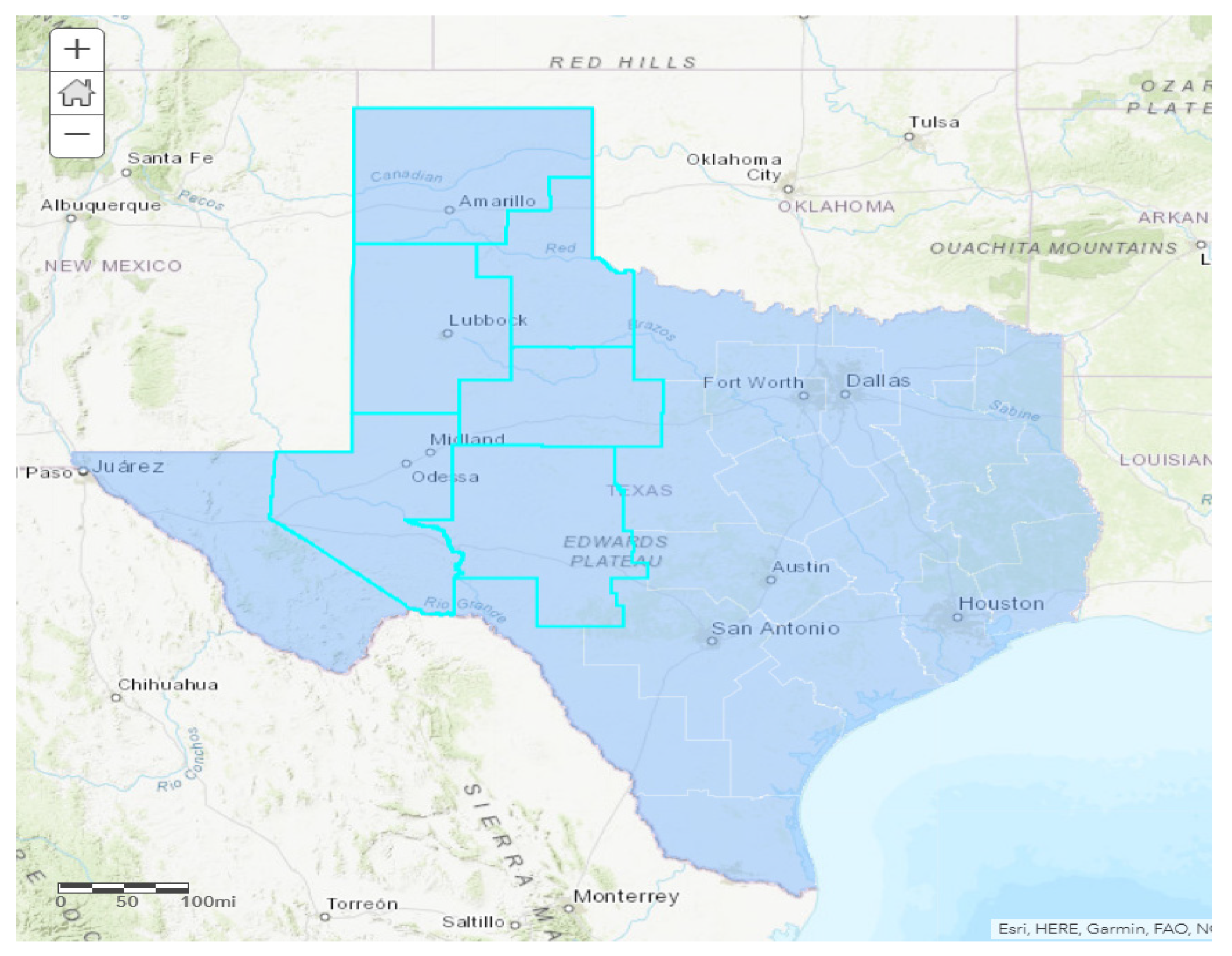
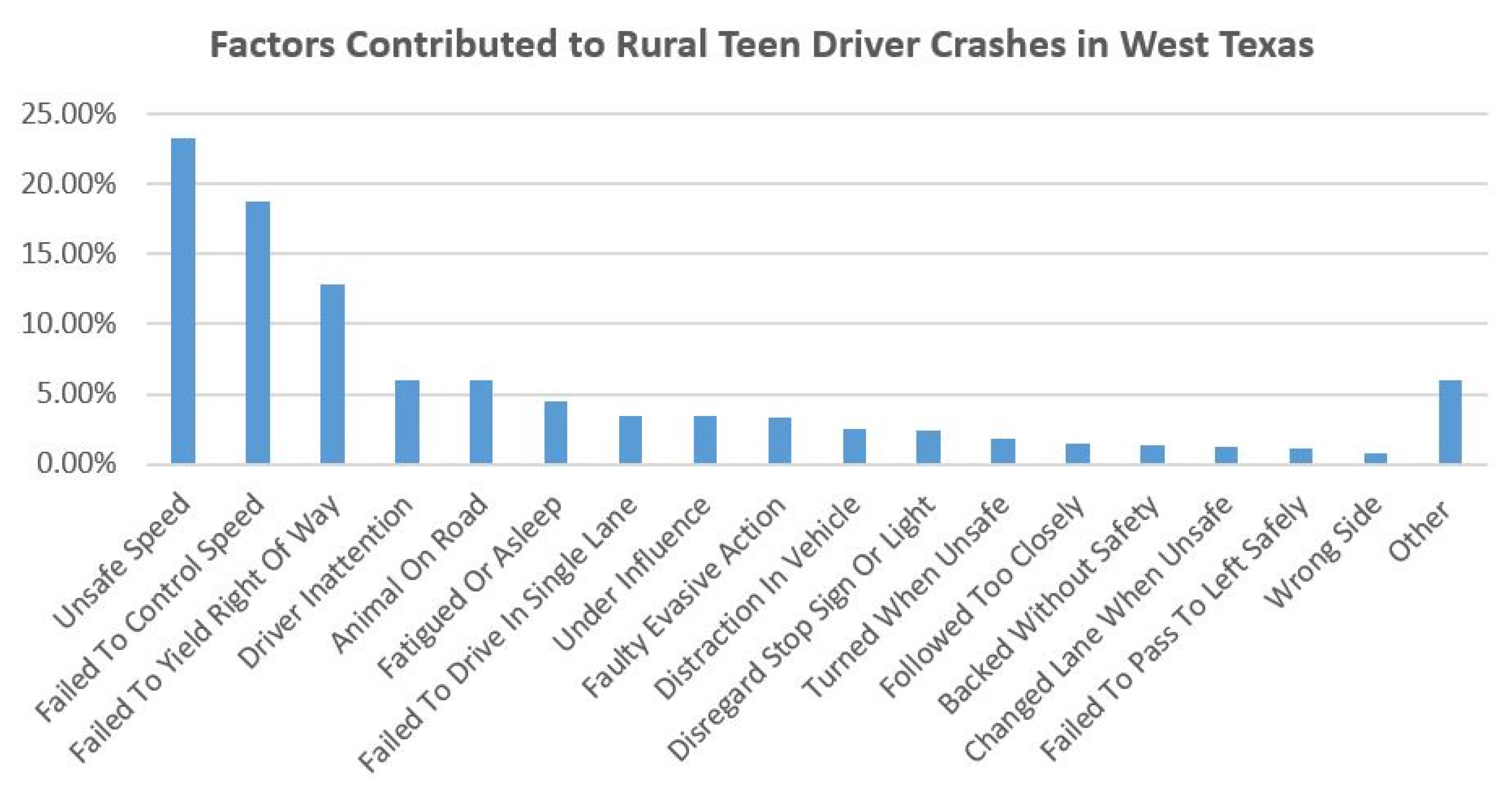
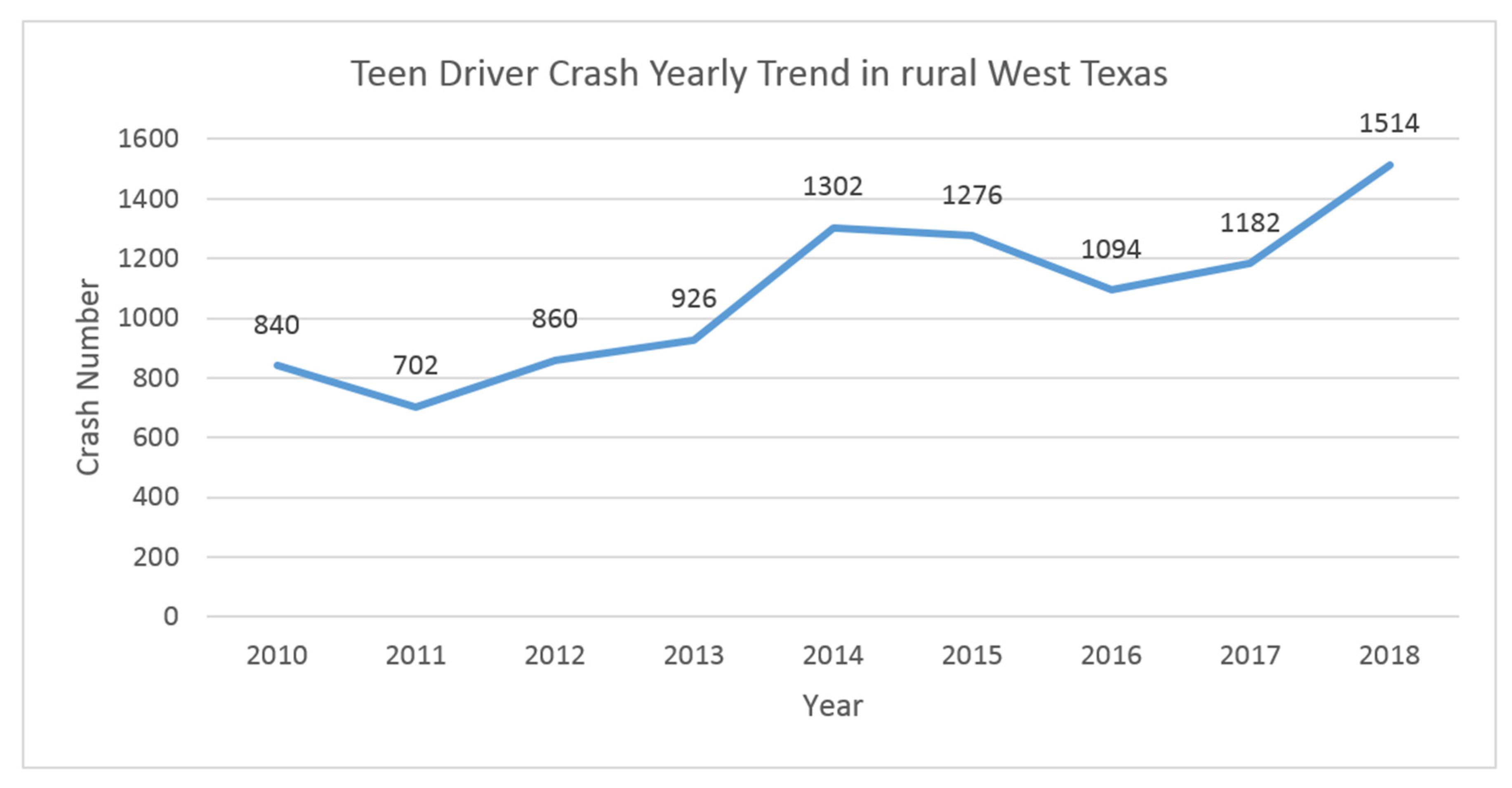
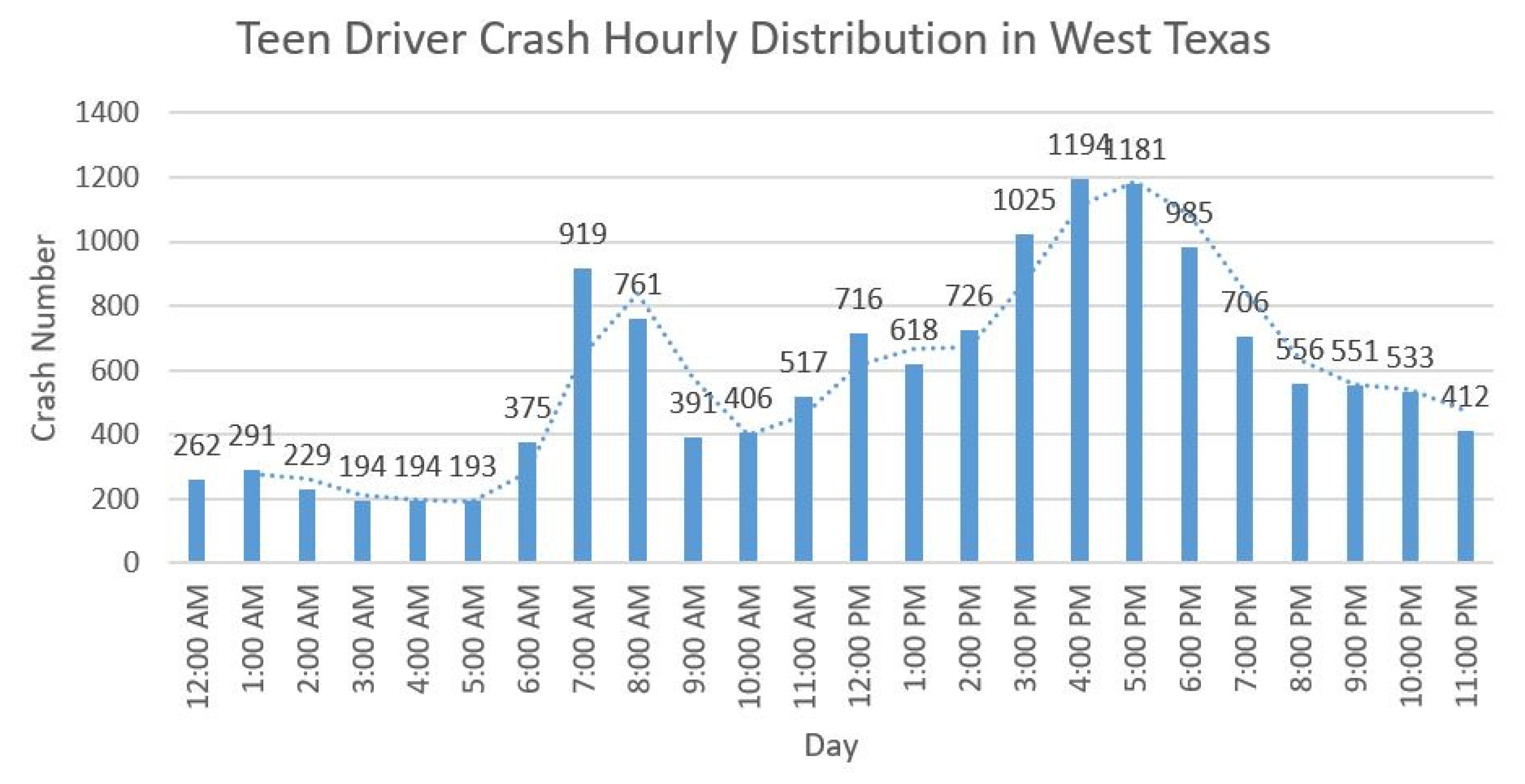

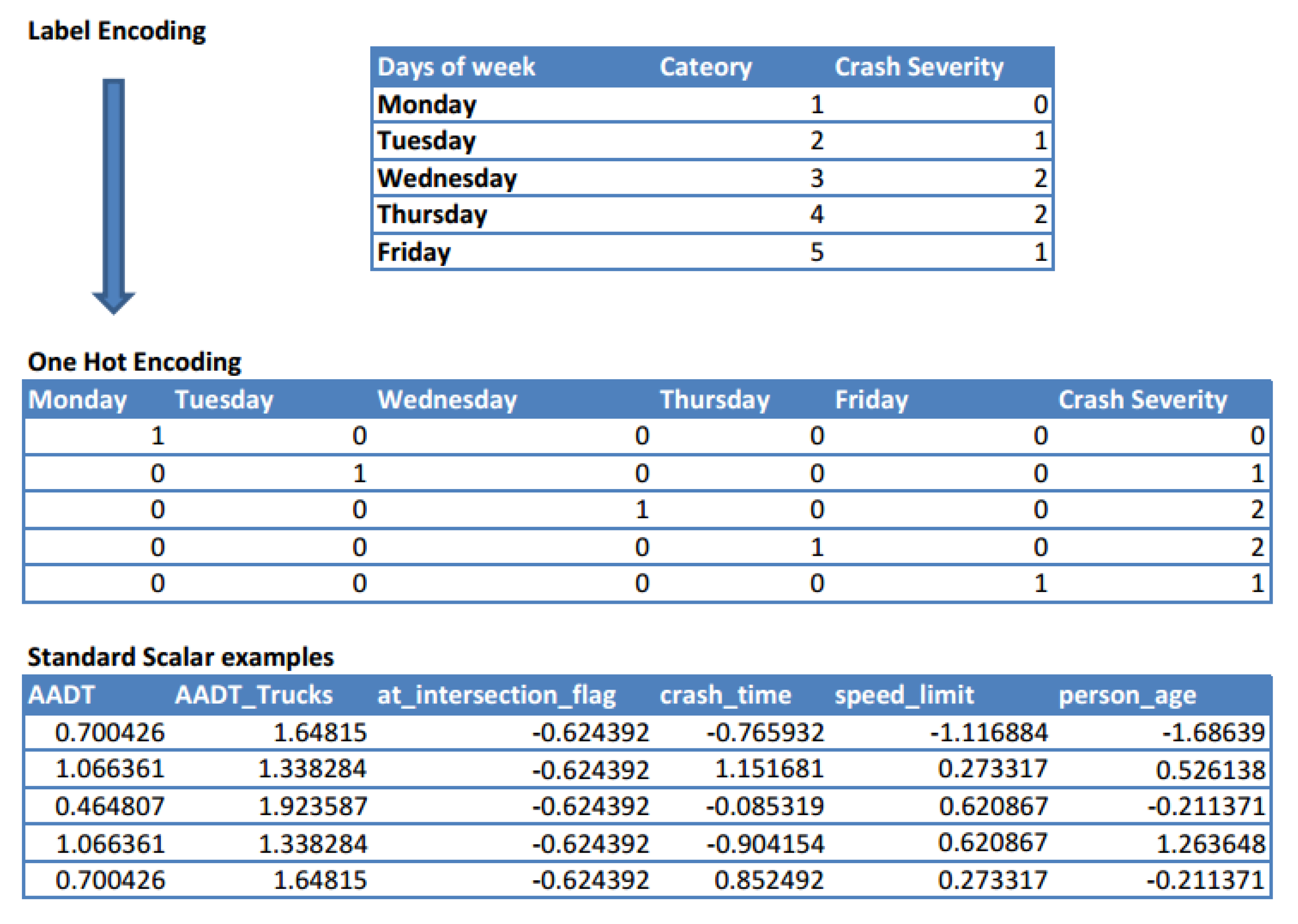
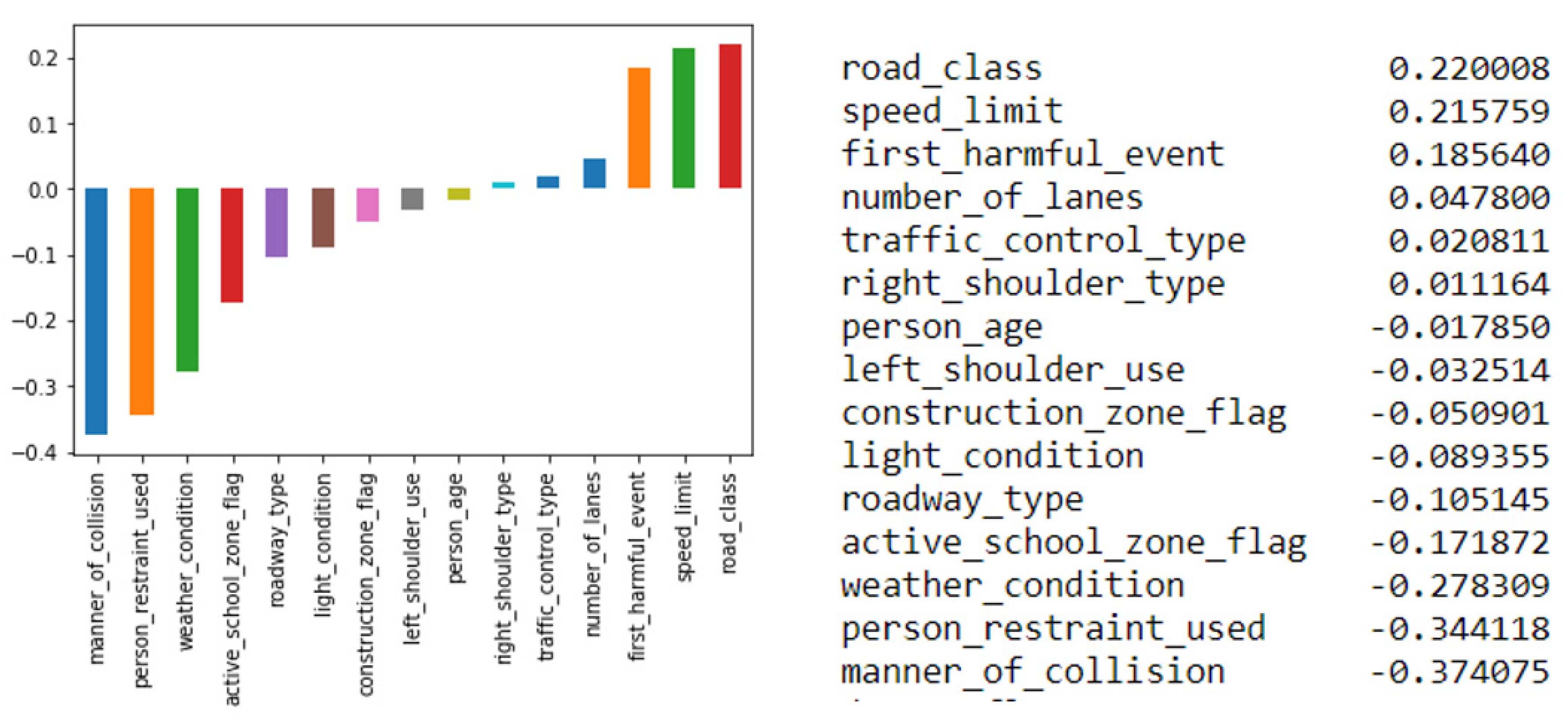
| Encoding Method | Predictive Algorithm | Mean Absolute Error (MAE) |
|---|---|---|
| One hot encoder | Random Forest | 0.7271 |
| One hot encoder | XGBoost | 0.7140 |
| Label encoder | Random Forest | 1.0634 |
| Label encoder | XGBoost | 0.7804 |
| Encoding Method | Predictive Algorithm | Time (second) |
|---|---|---|
| One hot encoder | Random Forest | 3.51 |
| One hot encoder | XGBoost | 2.49 |
| Label encoder | Random Forest | 1.12 |
| Label encoder | XGBoost | 0.76 |
© 2020 by the authors. Licensee MDPI, Basel, Switzerland. This article is an open access article distributed under the terms and conditions of the Creative Commons Attribution (CC BY) license (http://creativecommons.org/licenses/by/4.0/).
Share and Cite
Lin, C.; Wu, D.; Liu, H.; Xia, X.; Bhattarai, N. Factor Identification and Prediction for Teen Driver Crash Severity Using Machine Learning: A Case Study. Appl. Sci. 2020, 10, 1675. https://doi.org/10.3390/app10051675
Lin C, Wu D, Liu H, Xia X, Bhattarai N. Factor Identification and Prediction for Teen Driver Crash Severity Using Machine Learning: A Case Study. Applied Sciences. 2020; 10(5):1675. https://doi.org/10.3390/app10051675
Chicago/Turabian StyleLin, Ciyun, Dayong Wu, Hongchao Liu, Xueting Xia, and Nischal Bhattarai. 2020. "Factor Identification and Prediction for Teen Driver Crash Severity Using Machine Learning: A Case Study" Applied Sciences 10, no. 5: 1675. https://doi.org/10.3390/app10051675
APA StyleLin, C., Wu, D., Liu, H., Xia, X., & Bhattarai, N. (2020). Factor Identification and Prediction for Teen Driver Crash Severity Using Machine Learning: A Case Study. Applied Sciences, 10(5), 1675. https://doi.org/10.3390/app10051675







